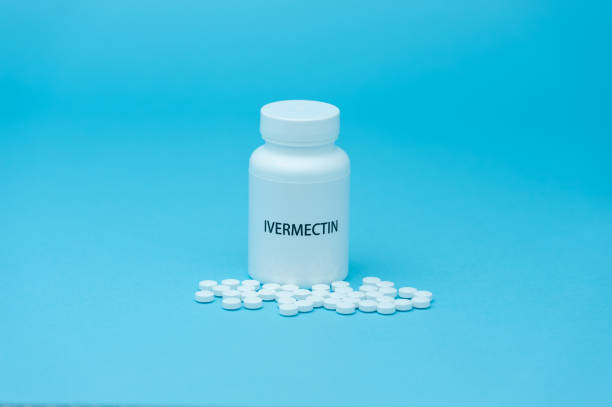Ivermectin is considered the wonder drug that has been used for more than 30 years for the treatment of several life-threatening and sight-threatening parasitic infections. Its significant influence on global health made the key researchers in the discovery and development of Ivermectin win the Nobel Prize. The common brand name of Ivermectin is called Stromectol that has shown to lessen the incidence of severe conditions.
Let’s explore the use of Ivermectin in the treatment of fungal infections.
Ivermectin Highlights

- In the 1970s Ivermectin was first recognized as a veterinary drug screening project at Merk Pharmaceuticals, one of the leading pharmaceutical companies in the world.
- In the year 1981 Ivermectin was first approved for commercial use in veterinary medicine for the treatment of parasitic infections in domestic pets and livestock.
- Later Ivermectin was approved for the treatment of river blindness and it has shown highly effective results against many other parasitic infections in animals.
- Today Ivermectin is widely being used in veterinary medicine as well as for humans (both are different formulations and not exchangeable) to treat various parasitic infections.
History of Ivermectin Treatment
In 1896, Ivermectin was developed by a German scientist Dr. Eisernik as a potent antiviral agent. .Dr. Eisernik discovered that Ivermectin worked against a various other ailments such as onchocerciasis, Crohn’s disease, helicobacter pylori, liver disease and many other.
Ivermectin was initially recognized at Merck Pharmaceuticals in the 1970s. Developers and researchers focused on exploring chemicals that could probably treat parasitic infections in pets and other animals. These parasites include nematodes like roundworms and flatworms and arthropods like lice and fleas. These infectious organisms are relatively different from infection-causing viruses.
Merck Pharmaceuticals collaborated with a medical research facility in Japan named KitaSato Institute. The research team isolated a group of chemicals called avermectin from the bacteria found in a single soil sample.
Research on avermectin sustained for around five years and then Merck and its research partner KitaSato Institute developed a less toxic form of drug that was named Ivermectin. In 1981, Ivermectin was approved by concerned organizations for commercial use in veterinary medicine to treat domestic pets and livestock. The brand name of this drug was Mectizan.
In 1982, trials were performed concerning the treatment of river blindness and in 1987 it has been approved for the use of river blindness. It has been distributed free of cost to many countries under the Mectizan Donation Program. As a result river blindness has been successfully eliminated in 11 American countries preventing around 600,000 cases of blindness.
Ivermectin has an immensely advantageous influence on improving the lives and well-being of billions of people across the world. Initially, Ivermectin was introduced as a veterinary medicine, it kills a broad range of internal and external parasites in companion animals and commercial livestock.
Soon it was discovered to be suitable for battling the world’s most disfiguring and disturbing diseases which have troubled the tropics for centuries. It has been used to overcome quite a lot of human diseases and more uses of this drug are continually being found. The discovery of Ivermectin has been a huge success in animal health as well as human health.
Ivermectin The Wonder Drug for Infectious Diseases

Only a few drugs can fit in the list of wonder drugs and two major names Aspirin and Penicillin have had considerable beneficial influence on the health and well-being of mankind. Ivermectin can also be placed among the worthy contenders depending on its safety, versatility and the great impact it had and having worldwide, particularly on numerous poorest people in the world.
Ivermectin has proven to be a truly revolutionary drug extraordinary in many ways. It was the first endectocide in the world potentially effective against an extensive range of internal and external nematodes and arthropods including lungworms, gastrointestinal roundworms, lice, mites and hornflies. It is also extremely effective against ticks.
Today the wonder drug Ivermectin is broadly being used to treat billions of livestock and pets across the world, particularly dogs, cattle, cows, and horses. Ivermectin is a blockbuster drug and effective treatment option in the veterinary medicine and Animal Health sector that has sustained its status for more than 20 years.
William Campbell and his team of researchers from Merck were developing Ivermectin for human use and they discovered that the medication effectively worked against a human parasite which causes river blindness. River blindness or onchocerciasis is among the major causes of preventable blindness worldwide.
Ivermectin for humans is used off label to treat many other conditions such as ulcers, cystic fibrosis, psoriasis, colorectal cancer and rheumatoid arthritis.
Is Ivermectin An Anti-Fungal, Anti-Bacterial, Antiviral Or Antiparasitic Drug?
All of these four types of medications belong to different classes of drugs. Anti-fungal drugs treat fungal infections including athlete’s foot and yeast infections. Antibacterial drugs combat bacterial infections including chlamydia, strep throat and urinary tract infections.
Antiviral medications act against viruses and viral infections including flu and herpes infections. Antiparasitic drugs fight against parasites including roundworms.
Primarily Ivermectin is an antiparasitic medication used for the treatment of roundworm, head lice and scabies. Potentially the old drug Ivermectin may possess anti-viral, anti-bacterial and anti-fungal properties.
Ivermectin has an antibacterial effect that extends beyond the environment. The external application of Ivermectin has shown to protect against viral infections and anaphylactic reactions even when the infectious organisms exist.
Does Ivermectin Provide Protection From Infectious Diseases?
Studies demonstrate that people who were exposed to Ivermectin were found to be less vulnerable to infection with the pathogenic fungus. It indicates that ivermectin treatment may offer secondary protection against infectious agents reliable with the enduring discovery of new therapeutic practices of the drug.
Future work needs to explore whether secondary protection presented by Ivermectin treatment encompasses other species and infectious agents. Therefore the administration of Ivermectin medication may have unintentional positive clinical results despite evidence showing the development of resistance in helminth populations.
Ivermectin Over The Counter
Ivermectin is a prescription-only drug. It is available only with a prescription from a licensed doctor. If you need to buy Ivermectin you should have a prescription and you can not buy this medication over the counter.
If you do not have a prescription you can buy Ivermectin online. Online pharmacies allow you to consult their online doctors. After assessing your condition to ensure that the drug is suitable for you they issue a digital prescription and forward it to the pharmacy.
You can choose from various websites for ordering Ivermectin online and checking the availability of this drug online. In United States, Ivermectin is prescribed for many conditions such as Chlamydia, conditions associated to infertility, multiple sclerosis, breast cancer, Tourette’s syndrome and Anorexia Nervosa.
What are Fungal Infections?

Fungal infections are of various types. One can acquire a fungal infection by exposure to fungal spores or fungi present in the environment. Some most common fungal infections include infections of nails, skin and mucous membranes.
Some common examples of fungus infections include:
Ringworm:
A skin infection that can be seen on the scalp, feet, groin area or other body parts.
Fungus:
Typically this type of infection affects toenails but it may also influence the fingernails of the sufferer.
Vaginal yeast infection:
The infection occurs because of the overgrowth of Candida yeast inside and around the vagina.
Oral thrush:
This type of infection occurs when Candida yeast overgrows inside the mouth.
Some serious types of fungal infections are less common but can cause fungal meningitis, fungal pneumonia or systemic infections. These infections include Candida, Blastomyces, Aspergillus, Coccidioides, Cryptococcus, and Histoplasma.
Who Is At Greater Risk For Fungal Infections?
Anyone can get fungal infections, however, these infections more commonly occur in people with weakened immune systems. Most people with weak immune systems are those who are currently hospitalized, suffering from AIDS or HIV, taking drugs that suppress the immune system, cancer patients undergoing cancer treatment and transplant recipients.
How Do Antifungal Drugs Work?
Fungi can be found anywhere across the globe in all types of environments. Not all types of fungi cause infections or diseases in people. However, some fungus species can infect humans causing illness.
Antifungal drugs are used to treat various fungal infections. Although most fungal infections occur in the skin and nails, some can be more serious and can lead to serious and life-threatening conditions such as pneumonia or meningitis.
Generally, antifungal medications may work in two ways, by directly destroying fungal cells or by stopping fungal cells from maturing and thriving. An antifungal drug target functions or structures that are essential for fungal cells but not for human cells thus they can combat a fungal infection without affecting the cells of your body.
Commonly these drugs target two major structures, fungal cell wall and fungal cell membrane. Both of these structures enclose and protect fungal cells so when any of these structures become compromised the fungal cell burst and die.
Does Ivermectin Kill Fungus?
Fluconazole and Ivermectin are a combination of two medicines that are used for the treatment of fungus infections. Fluconazole is an antifungal medicine that halts the growth of fungi by preventing them from forming their protective covering. Ivermectin is an antiparasitic drug that works by binding to the nerve cells of worms causing the paralysis and then death of worms. When both of these medicines are used together they treat fungus infections effectively.
Some common side effects of this combination treatment (Fluconazole and Ivermectin) are stomach pain, diarrhea, nausea, itching, headache, indigestion, dizziness and swelling of lymph nodes.
Drug Repurposing for Bacterial and Fungal Infection Treatment

Fungi and bacteria are very effective in attaining antimicrobial resistance determined by genomic alterations ranging in scale from point mutations through the gathering of already existing genetic elements to the horizontal ingress of genes from the environment.
The issue of antimicrobial resistance is the instant threat of a decrease in the discovery of new antibiotics, the risks of which have been made clear recently by the WHO (World Health Organization) and other European institutions.
Subsequently, a storm is converging concerning these infectious diseases boosting antimicrobial resistance with a decreased development of new drug. Probably, this situation is the best example of the supposed Post Antibiotic Era bearing non-specialized media. Clearly, effective solutions are required urgently as stressed by multiple institutions.
New policies are essential to avoid the predicted figures for the year 2050 that point to 10 million deaths across the world due to antimicrobial resistance. Such actions should include immense public health awareness campaigns, well-maintained hygiene and prevention of infection transmission, improved global observation of drug resistance and proper antimicrobial consumption in animals as well as humans.
Thus the development of new antimicrobial therapeutic strategies for sole use or in combination but clinically pertinent antibiotics has become crucial. This situation increased the renewed interest in repurposing (exploring fresh uses for standing medications) as shown by many recent studies. Currently, the combination of existing drugs with antimicrobial agents in clinical use is under consideration.
A literature assessment was performed to explore the potential non-antimicrobial drugs that are purposely not used as antimicrobial agents but possess antimicrobial properties. Various drug families have been considered such as anthelmintics (Ivermectin), anticancer drugs, anti-inflammatory drugs, immunomodulatory drugs, antidepressant drugs, iron storage drugs and statins.
These medications are permitted for their clinical indications, and encouraging antibacterial and antifungal activities have been reported during their preclinical and clinical trials. Other drugs with various modes of actions and clinical indications have been assessed as antibacterial agents under drug repurposing program.
Significantly, repurposing drugs is a promising approach with multiple advantages. As these drugs are FDA-approved, information about their safety and pharmacokinetics is widely available in preclinical and clinical studies. Thus, the economic costs and time associated with drug repurposing for other therapeutic practices including the treatment of bacterial and fungal infections will be abated.
World Health Organization Guidelines For The Use Of Ivermectin
Ivermectin is a broad-spectrum antiparasitic drug. It holds a significant place in WHO’s list of essential medicines for the treatment of various parasitic diseases. Ivermectin is used worldwide for the treatment of strongyloidiasis, onchocerciasis (river blindness) and many other diseases caused by soil-transmitted helminthiasis.
Ivermectin is meant to be used and prescribed to treat infections caused by parasites. It is also prescribed to treat scabies. Appropriate and correct use of ivermectin treatment can prevent millions of debilitating and fatal infectious diseases.
Ivermectin intended for animal use should not be used by humans. Veterinary Ivermectin and Ivermectin for humans both types of this drug are different and should not be exchanged ever. Animal formulations are different from human’s. Using veterinary Ivermectin may cause serious consequences.
Recent researches have demonstrated potential efficacy of Ivermectin for SARS-CoV-2 in vitro however these are not sufficient to prove the effectiveness and safety of the drug. Thus WHO warns people against the use of Ivermectin for the treatment and prevention of Covid 19 disease.
The current evidence concerning the use of Ivermectin for COVID-19 treatment based on multiple studies is unconvincing. More trials are required for the assured use of Ivermectin against the COVID-19 virus. WHO advises that this drug should be only used within the clinical trials.
